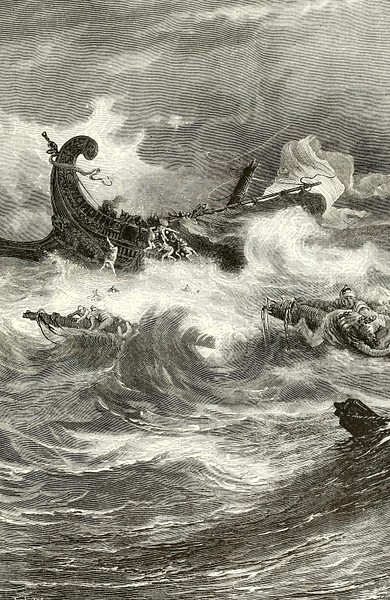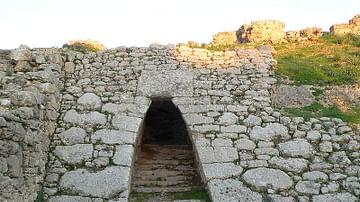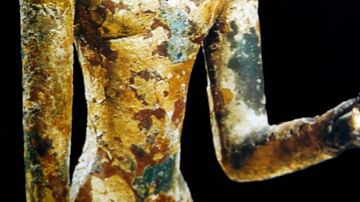
Yamm (from the Semitic word yam for 'sea', also known as Yam and Yam-Nahar) was the god of the sea and storm in the pantheon of the Canaanite-Phoenicians. Depicted consistently as tyrannical, angry, violent, and harsh, Yamm was the brother of Mot, the god of death, and is associated with chaos. His story is told in the Ugaritic Baal Cycle.
This association is furthered by his identification with Lotan the Leviathan, the monster who churned the seas. As Yam-Nahar (literally 'sea' and 'river'), he personified the destructive aspects of both. He was the son of El, the supreme god of the Canaanite and Phoenician pantheon, and is also referred to as Prince Yamm and "Beloved of El" in the myths of the region.
He is best known from the Ugaritic poem known as the Baal Cycle, which tells the story of his conflict with the fertility god Baal, his defeat, and Baal's supremacy over chaos and death. The tablets containing the Baal Cycle were unearthed in the excavation of Ugarit (in modern-day Syria) following the ancient city's discovery in 1928. These tablets date to c. 1500 BCE but are thought to have been a written record of a much older story passed down by oral transmission.
The story has often been compared to the Mesopotamian epic of the Enuma Elish, but there are significant differences in that, first of all, the Enuma Elish is a cosmogony (detailing the beginnings of the world/universe) while the Baal Cycle is not, and, secondly, Yamm and Mot in the Baal Cycle are not as neatly defined as villains as Tiamat and Quingu are in the Enuma Elish.
Both stories, however, serve the purpose of explaining the world to an audience. The Enuma Elish details how order rose from chaos and how the visible and invisible worlds came to be established; the Baal Cycle describes those worlds already in operation and explains why events happen as they do. As in all ancient cultures, the gods served to explain the seemingly inexplicable and give reason to events that may seem random or mysterious. Scholars Michael D. Coogan and Mark S. Smith comment:
As a group, the gods and goddesses of the Canaanite pantheon are larger than life. They travel by giant strides – "a thousand fields, ten thousand acres at each step" – and their control over human destiny is absolute. In their personified forms, the deities embody realities beyond human understanding and control: the storms necessary for prosperity and even survival, the powerful drives of sex and violence, the final mystery of death. The gods and goddesses belong to a divine society that mirrors society on earth; for example, both share the patriarchal institution of kingship. The solutions of the problems of that "heavenly city" in their stories gave the Canaanites hope for the future.
(8)
In this, the pantheon of the Canaanites was no different than those of other ancient civilizations, and the stories the people told had the same purpose. The symbols and motifs found in the Baal Cycle are also apparent in other religious works of the Near East, and the story of the struggle between order and chaos is treated in pieces from Mesopotamia through Egypt to Greece and beyond.
An interesting aspect of the Baal Cycle, however, is how Yamm – the supposed villain of the piece along with Mot – is not guilty of usurping power (as in the tale of Set and his murder of the god-king Osiris in Egyptian mythology) nor of triumphing the cause of chaos (as the Titans in their war with Zeus in Greek mythology), but of misusing the power he was given legitimately.
Summary of the Baal Cycle
[Author's Note: This summary is based on the translation by Mark S. Smith, The Ugaritic Baal Cycle, Volume I, Brill Publishers, 1994]:
Baal, son of Dagon, is hopeful he will be chosen by El, chief of the gods, to be king, but El instead gives the crown to his son Prince Yamm. Since El is all-wise and benevolent, it is thought that his choice of Yamm would be in the best interests of all, but once Yamm has power, he becomes a tyrant and forces the other gods to labor for him. The gods cry out to their mother – El's consort, Asherah – who goes to Yamm to intercede for them. She offers him various gifts and favors, but he refuses until she offers him her body. Yamm accepts and Asherah returns to the divine court of El to tell them of the contract.
The other gods in council all seem to agree with Asherah that this is a sound plan, but Baal is disgusted by it and by the other gods who would even think of allowing it. He swears he will kill Yamm and end the tyranny himself. Some of the gods present alert Yamm to Baal's treason, and Yamm sends emissaries to the court of El demanding that Baal be surrendered for punishment.
All the other gods bow their heads before the emissaries except for Baal, who defies them and rebukes the other gods for their cowardice. A second set of emissaries is sent by Yamm, again demanding the gods surrender Baal. These messengers show El and the other gods no respect and refuse to participate in even the smallest rites of courtesy. Even so, instead of calling them to account or punishing them, El tells them that he will surrender Baal and that Baal will come before Yamm bearing gifts of gold.
Baal is enraged and moves to attack the emissaries but is held back by his sister Anat (the war goddess) and his consort Astarte (the goddess of love). They tell him that he cannot kill the messengers, for they are only relaying the words of their master and have no say in the matter. Baal relents and spares them but again swears he will not bow to Yamm and will not surrender himself. He cannot defeat Yamm in combat, however, because of Yamm's great strength, but at this point, Kothar-wa-Khasis, god of craftsmanship, the forge, and weapon-making, speaks up.
Kothar tells Baal he will create two clubs for him, Yagrush and Aymur, which will destroy Yamm. Kothar delivers the clubs, and Baal goes to meet Yamm in combat. He swings Yagrush down upon the king, striking him on the shoulders, but Yamm does not fall, and Baal retreats. Kothar tells him to use Aymur now and strike at Yamm's head, between his eyes. Baal does so, and Yamm falls, defeated. Baal drags him back to the council hall, proclaims himself the new king, and then casts Yamm out of the heavens. Yamm returns to his former role as god of the sea.
In the second part of the poem, Mot, the god of death, is offended by Baal and seeks to destroy him. He sends the sea creature Lotan (closely associated with Yamm as either an alter ego or a comrade) to kill Baal, but Baal kills Lotan instead. Mot swears he will not rest until Baal is dead and he, Mot, has eaten him. To escape Mot, Baal pretends he has been killed and goes into hiding. His ruse fools even the other gods and provokes his sister Anat to seek revenge. She kills Mot, but, since he is immortal – like all the gods – he returns to life. At this point, Baal returns from hiding and subdues Mot; though, of course, he cannot kill him. Mot returns to his dark realm and Baal reigns as the king of the gods.
Yamm in the Poem & in Canaanite Culture
Yamm plays the villain in the piece primarily because of his insecurity. Instead of treating the other gods with respect, he subjugates them in order to elevate himself and maintain control of the situation. Unlike his father El, who believes in listening to others and weighing their counsel, Yamm is too insecure as a king to allow for dialogue and becomes a tyrant in order to suppress any challenge to his authority. He will not compromise because, in his view, this would be seen as weakness.
Yamm and Baal are depicted as being about the same age. They are young gods, unlike El and Asherah, and they both lack experience. The difference between them is Baal's ability to listen to others and respect their counsel, as when he listens to Anat and Astarte and spares the messengers of Yamm. Baal, symbolically, represents the cooperative and life-giving aspects of nature, most evident in his role as the god of rain, which fertilizes the earth and causes the crops to grow. Yamm, as the god of the sea and rivers, symbolizes the violent and uncompromising side of nature as experienced by the Canaanite-Phoenicians through their voyages on the seas and periodic flooding of their lands.
The Canaanite-Phoenicians were known by the Greeks as the 'purple people' (owing to the dye manufactured at Sidon and used extensively at Tyre), but also as 'the horse people' because of the ornately carved horse heads which adorned the prows of their ships. These horse heads were purposeful tributes to the might of Yamm and were used on the ships to placate the god, who, like the Greek god Poseidon, was associated with horses, and who had to be constantly appeased to prevent his wanton destruction of the ships at sea.
Even so, Yamm was never considered a force of evil (and neither was Mot), but simply one to be reckoned with and acknowledged. Scholar Aaron Tugendhaft, among others, notes that administrative lists and deeds from Ugarit contain personal names attesting to the worship of Yamm as a benefactor, such as "Servant of Yamm", "Yamm is God", and "A King is Yamm" (150). Further, Tugendhaft notes that Yamm was considered worthy of sacrificial ritual, just as Baal, El, and other gods were, and received the same sacrificial ram they did (149).
Yamm, therefore, although considered the villain of the Baal Cycle, was not thought to be an evil or villainous god by the Phoenicians. Even so, it is thought that Yamm would serve as a model for later works featuring an evil supernatural being and mirrored older works on the same subject of order-vs-chaos, especially from Egypt.
Yamm & the Myths of Other Cultures
In some versions of the Phoenician myth, Yamm, the chaotic force, is in constant conflict with Baal, the force of order. Baal and Yamm meet each other in combat on the plains of heaven, and, after his defeat, Yamm is cast out of heaven and into the depths of chaos in the sea. Still, Yamm wishes to dethrone Baal and rule in heaven, and so, in these versions, he comes back from the depths beneath the seas to battle for heaven's gates, bringing chaos with him again and again in a never-ending cycle.
Even so, each time, Yamm is exiled to the seas where he directs his rage against humans and plots against Baal until he can launch another assault on heaven. Yamm and Baal continually kill each other, resurrect, fight, and die, only to return to life once more. This version of the tale has been thought a symbolic explanation for the cycle of the seasons in Canaan/Phoenicia (addressing the same need as the tale of Demeter and Persephone did in ancient Greece). Yamm, and then Mot, in the Baal Cycle both interrupt the natural operation of the universe, and this is understood as symbolizing periods of drought or flood and famine in the land: Yamm or Mot were interfering with the way Baal governed and regulated nature.
Tugendhaft notes how, unlike a cosmography such as the Enuma Elish, the kingship and order of the universe are already established in the Baal Cycle, and, therefore, there should be no problems with its continuance (154). The fact that human beings experienced suffering in the form of floods, drought, famine, and death, however, begged for some explanation, and the Baal Cycle provided this.
The purpose of the Baal Cycle is similar to that of the Osiris-Set cycle from Ancient Egypt in which the kingship is already established and order prevails, with Osiris as a benevolent ruler when the story begins. His brother Set, just as inexperienced with rule as Yamm, murders Osiris and takes the throne, plunging the land into chaos. Set, like Yamm, is also not seen as an evil deity and, in some eras of Egyptian history, was among the gods who saved the sun god from destruction by the primordial serpent Apophis.
Like Yamm, Set was also venerated through personal names (such as Seti). The Egyptians believed that their land was perfect, given to them by the gods and imbued with harmony, and yet they still suffered from various natural calamities. As in the Baal Cycle, the story of Set and Osiris explained to the people the origin of suffering as chaos vied with order for supremacy and upset the natural balance of the universe.
This theme of order-vs-chaos was picked up by later religious scribes. The battle between Baal and Yamm, ending with Yamm cast out of heaven and afterwards taking his revenge on El's creations, has been cited as the model for the later Christian myth of the fall of Lucifer and of the Devil's subsequent troubling of human beings ever after.
According to still other scholars, Yamm is identical to the god Lotan, represented as a serpent or a many-headed dragon, and is the model for the origin of Satan in the biblical Book of Revelation (12:9). He is seen as the inspiration for the tradition which associated the Christian devil with a serpent, most notably the serpent in the Garden of Eden in the third chapter of the Book of Genesis, although this claim has been challenged. The association of Yamm with Lotan, however, does seem to have influenced the biblical scribes in their creation of the Leviathan (a sea creature or sea monster), who is referenced in the Book of Job, the Book of Jonah, and elsewhere.
Yamm has also been associated with the Greek god Poseidon in his more violent and spiteful moments. Although some have tried to also draw a connection between Yamm and the Greek goddess of chaos, Eris, there are significant differences in motivation and action in that Eris is calculating and crafty in her desire to turn order upside down and her actions are subtle, while Yamm seems entirely motivated by ego; his actions are apparent and he makes no secret of his contempt for the other gods and their puny creations, humans.
Conclusion
For all his faults, however, Yamm was considered a god worthy of veneration. Although he could raise the seas to sink ships and send floods across the land, he could also help sailors reach their destinations safely and provided for the people of the land as long as they acknowledged and honored him.
In doing so, the Canaanite-Phoenicians were simply acknowledging the uncertain aspects of human existence and placing their hopes in the god who could cause them the most harm or bring them the greatest good. The stories concerning Yamm, like those of any ancient or modern belief system, finally served to give meaning to unfortunate events in the people's lives, which, otherwise, would have been unendurable.








